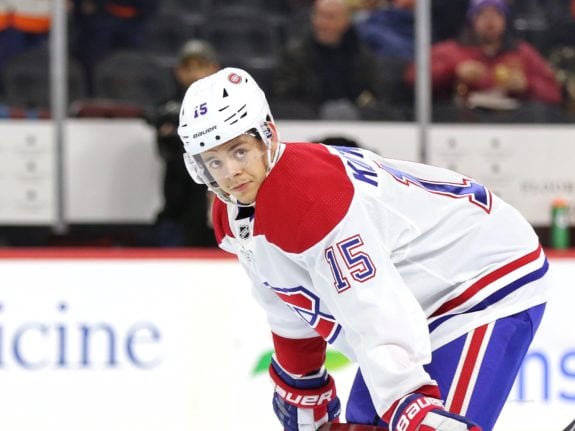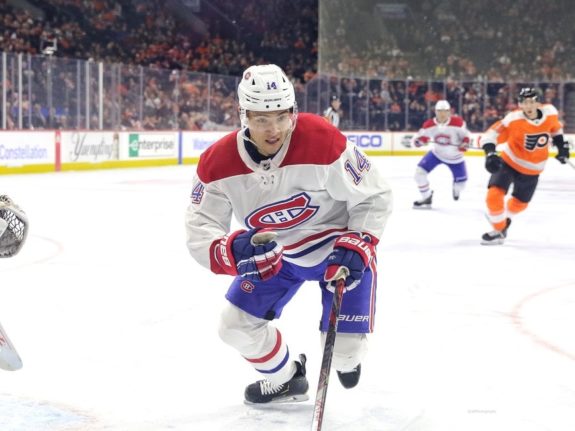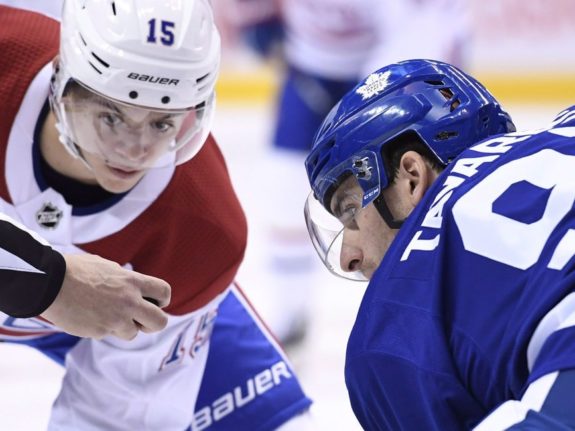The Montreal Canadiens have done what was once considered impossible by many – they defeated the Pittsburgh Penguins in four games in the best-of-five qualification-round series. This means the fans that had been excited at the 12.5 percent chance of winning the draft lottery will need to now focus on something positive to help them temporarily forget what could have been.
Related: Canadiens’ Ken Dryden – Truly One of a Kind
What could help is to focus on the much-needed experience and confidence gained for a couple of young centers already in the Bleu, Blanc, et Rouge. How has this short but dramatic play-in series, and any subsequent playoffs, helped to add to the development of Nick Suzuki and Jesperi Kotkaniemi?
Center of Attention
The issue that has nagged at the Canadiens and their fanbase for over two decades has been a lack of top talent at center. The importance at center has long been debated on social media and message boards for years. Fans simply have to look at the list of Stanley Cup champions over the last 30 years to see that talent and depth at center correlate to a contending team.
As Brian Wilde, a reporter who has covered the Montreal Canadiens for many years, likes to tell us “win the middle, win the game”.
No one gave much hope for the Canadiens’ to win the series against Pittsburgh, especially as Suzuki and Kotkaniemi would be facing off against the Penguins two-headed monster at center in Sidney Crosby and Evgeni Malkin.

Yet they persisted. The elder statesman at center, 27-year-old Phillip Danault, was tasked with playing a defensive role as well as top-unit penalty-killing. He led the team in faceoff percentage, winning 56.5 percent of his draws. He played an average of 20:27 per game facing either Crosby or Malkin depending on how Penguins head coach Mike Sullivan double-shifted his stars. Danault’s efforts in taking on some of the heavy workload can’t be understated in setting the table for the Habs young centers to focus on their roles.
A New Hope
Head coach Claude Julien even called the young duo of centers the difference in the series:
“If we didn’t have the contribution of those two players, I’m not sure I’d be here right now having won this series”
Claude Julien
The development steps forward by the two 20-year-old centers (Suzuki will be 21 years old on Aug. 10), didn’t go unnoticed by their captain either, with Weber stating:
“Those guys took huge steps. Even through the pause over three months they’ve gotten even better. I’m not sure how it would look playing games, but they obviously did work at home—whether it’s off the ice or skating. They’ve definitely gotten better and it’s a big, big help for us.”
Shea Weber
The Youth
Julien gets criticized by the fanbase for not trusting his younger players, however, Suzuki was one of the most-used Canadiens forwards averaging 20:33 minutes per game in ice time.

Suzuki had the benefit of playing in a long playoff run with the Ontario Hockey League’s Guelph Storm during their 2019 OHL Championship run and Memorial Cup appearance. This experience helped Suzuki to develop his two-way play. That experience and his play throughout the season earned Julien’s trust.
Suzuki was tasked in this series with matching up against Penguins star center Malkin who finished the four-game set with only one assist and a minus-three rating. Suzuki was also trusted to play on the penalty-killing units as well. The Canadiens PK was a key part of this series, shutting down the potent Penguins forwards and allowing only three power-play goals in 19 chances for an 84.2 percent PK rate.
Suzuki had also provided offence in this series. In Game 1 of the series, Suzuki won a puck battle against the boards, used his speed to create a two-on-one, kept his head up and saw a shot was his best option but froze Matt Murray by looking off to pass just as he fired his shot.
The other young center Julien praised was 20-year-old Kotkaniemi who came into camp with many question marks. He came into Phase 3 camp healthy with something to prove. By the end of camp, he had cemented his role as the third-line center over Max Domi and the hope was that Kotkaniemi could be a difference-maker in the series.

Despite his average ice time of only 13:14 minutes, Kotkaniemi was indeed a difference-maker in this series. His line with Paul Byron and Artturi Lekonen had a Corsi For percentage of 61.2 percent in the series, meaning they generated the majority of shot attempts when on the ice. His line was also used as an energy line by Julien after a Canadiens’ PK in an attempt to regain momentum.
Related: Maurice “Rocket” Richard: More than Just a Game
With limited ice time, Kotkaniemi also led the team in goals (tied at two with Shea Weber and Jeff Petry) and hits with 19 (an average of 4.75 per game). His goals were the result of his realization that he can use his large frame to muscle his way into the slot and use that ability to get to the front of the net. His first goal, also the first in the series, was a direct result of his newfound aggressive play.
His second goal was in the exact same location, at the top of the crease, where he out-worked the defender and was able to use his quick reaction to score on the rebound.

While fans will mourn the loss of the opportunity to win the draft lottery and select Alexis Lafreniere first overall, they can celebrate the experience their young centers are gaining. The importance of playing key roles in shutting down the Penguins and advancing to play the Philadelphia Flyers in the first round can’t be ignored.
Playoff experience for these young centers is integral to their eventual development into the Canadiens’ top-six centers. It is true that the NHL’s play-in format made it possible for the Canadiens to miss out on a high draft pick. However, it was the play of the young players that fans have been boasting about that made it happen. Canadiens fans may have just finally witnessed a future at center that they have been waiting 20 years to see.